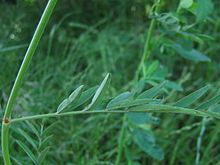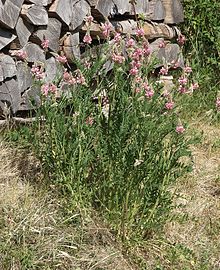Seed Esparsette
| Seed Esparsette | ||||||||||||
|---|---|---|---|---|---|---|---|---|---|---|---|---|

Seed Esparsette ( Onobrychis viciifolia ) |
||||||||||||
| Systematics | ||||||||||||
|
||||||||||||
| Scientific name | ||||||||||||
| Onobrychis viciifolia | ||||||||||||
| Scop. |
The Saat-Esparsette ( Onobrychis viciifolia ), also called forage-Esparsette , in earlier centuries sometimes Esparcette, is a species of the genus of the Esparsette ( Onobrychis ) in the subfamily of the butterflies (Faboideae). They are mainly used as dry fodder and as a soil improver .
description
Appearance and leaf
The Saat-Esparsette grows as a perennial herbaceous plant and reaches heights of 30 to 90 centimeters. The stem is erect. The alternate leaves are arranged in a petiole and a leaf blade. The imparipinnate leaf blade has six to twelve pairs of leaflets. The leaflets are ovate with a length of 15 to 25 millimeters and a width of 4 to 7 millimeters.
Inflorescence, flower and fruit
The long-stalked, densely-flowered, racemose inflorescence is ovate before opening, rounded at the top and about 1.5 to 3 centimeters wide at the time of flowering. The flower stalks are only 1 to 1.5 millimeters long. The bracts are 3.5 to 4 millimeters long and only slightly shorter than the calyx.
The hermaphrodite flowers are zygomorphic and five-fold with a double flower envelope . The five sepals are woolly hairy. The predominantly pink-colored petals with a few shades of white are 10 to 14 millimeters long and stand together in the typical shape of the butterfly flower . The flag is about the same length as the boat . The blunt, often purple veined wing is 3 to 4 millimeters long and shorter than the calyx.
The legumes are 6 to 8 millimeters long and have a comb covered with six to eight thick up to 1 millimeter long spines .
The flowering period extends from May to July. The fruits ripen from July to September.
Chromosome number
The number of chromosomes is 2n = 28.
ecology
The Saat-Esparsette is a hemikryptophyte (stem plant), a raw soil pioneer and a deep-rooting , because it roots up to 4 meters deep to adapt to drought. It has root nodules with nitrogen-fixing bacteria .
In terms of flower ecology, it is a question of weakly male "butterfly flowers with a folding mechanism". The flag is equipped with a purple veining as a sap mark. When sufficiently heavy insects sit down, the boat folds down so that the insect's belly is covered with pollen or later touched by the scar . In a later flowering stage are pen enabled. Nectar is abundant and accessible to short-nosed bees ; the plant is therefore a good pasture for bees. Melitta dimidiata only visits Esparsettes. In addition to numerous species of bees, butterflies and hoverflies have also been observed as pollinators . Self-pollination is not possible. The Saat-Esparsette is a forage plant of the endangered Esparsette-Ram .
The fruits stick with their prickly surface on animals and are carried away ( Velcro spread ). It is also likely that ungulates spread randomly .
Occurrence
The Saat-Esparsette originally comes from the Mediterranean , Southeastern Europe and Siberia . It was brought by humans with the colonization of Central Europe and is therefore considered a naturalized archaeophyte there . In the 18th century it was cultivated as a fodder plant in Central Europe , where it has become wildly unstable. In the Central European lowlands it is almost completely absent, in the Central European Central Uplands with lime-poor rock and in the Alps with lime-poor rock it is absent in some areas; otherwise it appears scattered in Central Europe. In Germany, the Saat-Esparsette is only relatively scattered. It occurs in the rest of Europe and Western Asia . In the New World it is considered a neophyte .
The Saat-Esparsette colonizes sunny, limestone, poor grass , semi- arid grass , light dry bushes, roadsides and embankments. It thrives best on warm, lime-rich , moderately dry, mostly deep loam and loess soils . In the Allgäu Alps, it rises in Vorarlberg am Hirschberg near Bizau to an altitude of 1500 meters.
According to Ellenberg , it is a light plant, a heat pointer, distributed subcontinentally, a dry pointer, preferring places with little nitrogen and a type of association of sub-oceanic semi-arid grasslands (mesobromion). It thrives in Central Europe especially in mown semi-arid grasslands with Bromus erectus .
Taxonomy
Onobrychis viciifolia was first published in 1772 by Giovanni Antonio Scopoli . The generic name Onobrychis is derived from the Greek words ωνος onos "donkey" and βρύχειν brychein "bite, eat, grind your teeth". The specific epithet viciifolia means "wickenblättrig". Synonyms for Onobrychis viciifolia Scop. are: Hedysarum echinatum Gilib. , Hedysarum onobrychis L. , Onobrychis sativa Lam. , Onobrychis viciifolia subsp. sativa Thell. , Onobrychis viciifolia subsp. sativum (Lam.) Thell. , Onobrychis vulgaris Hill .
use
The fodder sasparsette is a protein-rich dry fodder plant and a soil improver . It is eaten by horses and cattle. As a pasture plant , however, it was displaced by other plants that were better suited for intensive use. The cultivation has been taking place since the 16th century, but it has declined significantly in recent times. It is not uncommon for them to be planted as a soil improver. Due to its high tannin content , it is now again being given greater importance as a herbal wormer in animal husbandry.
swell
- Margot Spohn, Marianne Golte-Bechtle: What is blooming there? The encyclopedia: over 1000 flowering plants from Central Europe. Kosmos, Stuttgart 2005, ISBN 3-440-10326-9 .
- Siegmund Seybold (Ed.): Schmeil-Fitschen. Interactive flora of Germany. Seeing - determining - knowing. The key to the flora . CD-ROM, version 2.0. Quelle & Meyer, Wiebelsheim 2004, ISBN 3-494-01368-3 .
- Ruprecht Düll , Herfried Kutzelnigg : Pocket dictionary of plants in Germany. A botanical-ecological excursion companion to the most important species . 6th, completely revised edition. Quelle & Meyer, Wiebelsheim 2005, ISBN 3-494-01397-7 .
- Siegfried Schlosser, Lutz Reichhoff, Peter Hanelt: Wild Plants of Central Europe. Use and protection. Deutscher Landwirtschaftsverlag, Berlin 1991, ISBN 3-331-00301-8 .
Individual evidence
- ↑ Onobrychis viciifolia Scop., Saat-Esparsette. In: FloraWeb.de.
- ↑ a b c Erich Oberdorfer : Plant-sociological excursion flora for Germany and neighboring areas . 8th edition. Verlag Eugen Ulmer, Stuttgart 2001, ISBN 3-8001-3131-5 . Page 607.
- ↑ a b c d e Dietmar Aichele, Heinz-Werner Schwegler: The flowering plants of Central Europe . 2nd Edition. tape 2 : Yew family to butterfly family . Franckh-Kosmos, Stuttgart 2000, ISBN 3-440-08048-X .
- ↑ Eckehart J. Jäger, Klaus Werner (Ed.): Exkursionsflora von Deutschland . Founded by Werner Rothmaler. 10th edited edition. tape 4 : Vascular Plants: Critical Volume . Elsevier, Spektrum Akademischer Verlag, Munich / Heidelberg 2005, ISBN 3-8274-1496-2 .
- ↑ Erhard Dörr, Wolfgang Lippert : Flora of the Allgäu and its surroundings. Volume 2, IHW, Eching 2004, ISBN 3-930167-61-1 , p. 150.
- ↑ Heinz Ellenberg : Vegetation of Central Europe with the Alps in an ecological, dynamic and historical perspective (= UTB for science. Large series . Volume 8104 ). 5th, heavily changed and improved edition. Eugen Ulmer, Stuttgart (Hohenheim) 1996, ISBN 3-8252-8104-3 , pp. 1049 .
- ^ Rudolf Schubert, Günther Wagner: Botanical Dictionary. 12th edition. Eugen Ulmer, Stuttgart 2000, ISBN 3-8001-2742-3 , p. 391.
- ↑ Günther Blaich: data sheet with photos.
Web links
- Seed Esparsette. In: FloraWeb.de.
- Seed Esparsette . In: BiolFlor, the database of biological-ecological characteristics of the flora of Germany.
- Profile and distribution map for Bavaria . In: Botanical Information Hub of Bavaria .
- Onobrychis viciifolia Scop. In: Info Flora , the national data and information center for Swiss flora . Retrieved November 21, 2015.
- Thomas Meyer: Data sheet with identification key and photos at Flora-de: Flora von Deutschland (old name of the website: Flowers in Swabia )
- Photos:
- Paul Westrich: Flower visit of Anthidium oblongatum on Esparsette.
- Paul Busselen: Plant Guide Katholieke Universiteit Leuven.
- Onobrychis viciifolia inthe IUCN 2013 Red List of Threatened Species . Posted by: G. Vörösváry, K. Uzundzhalieva, O. Maslovky, R. Vögel, V. Holubec, 2010. Accessed October 16, 2013.



